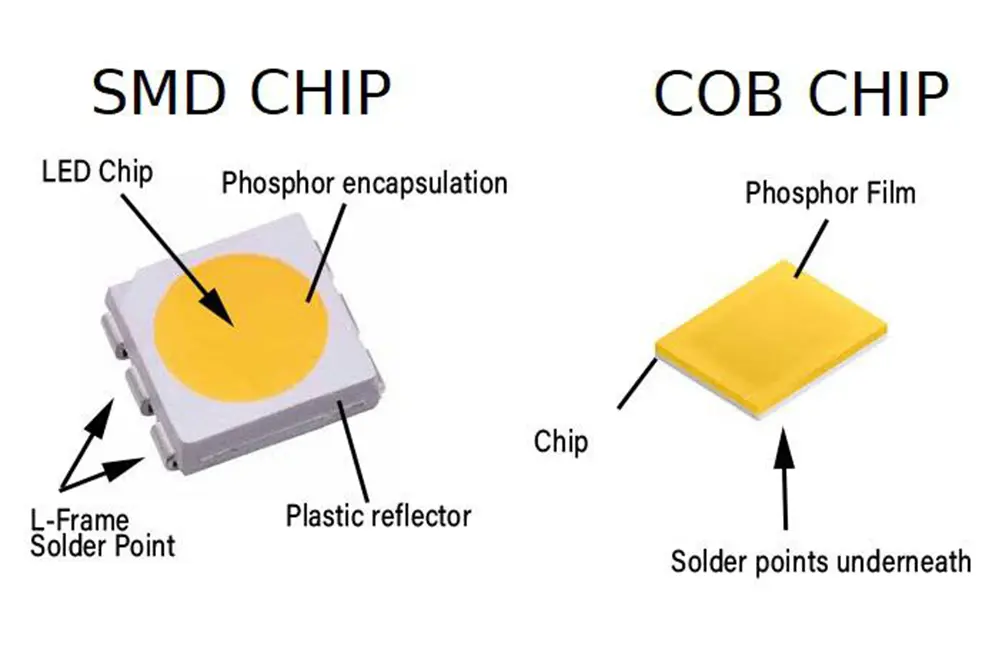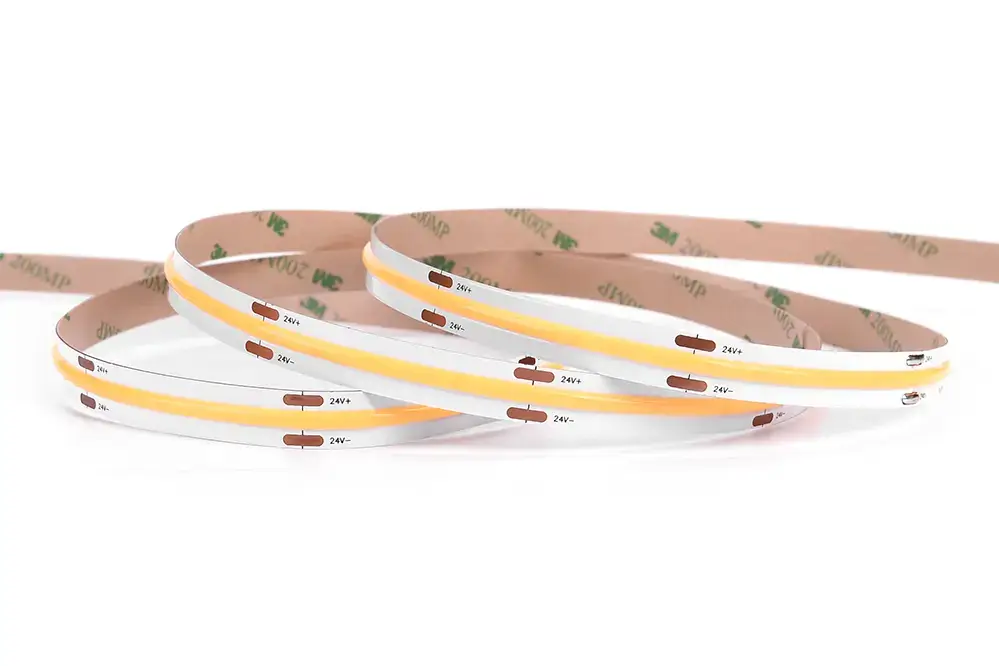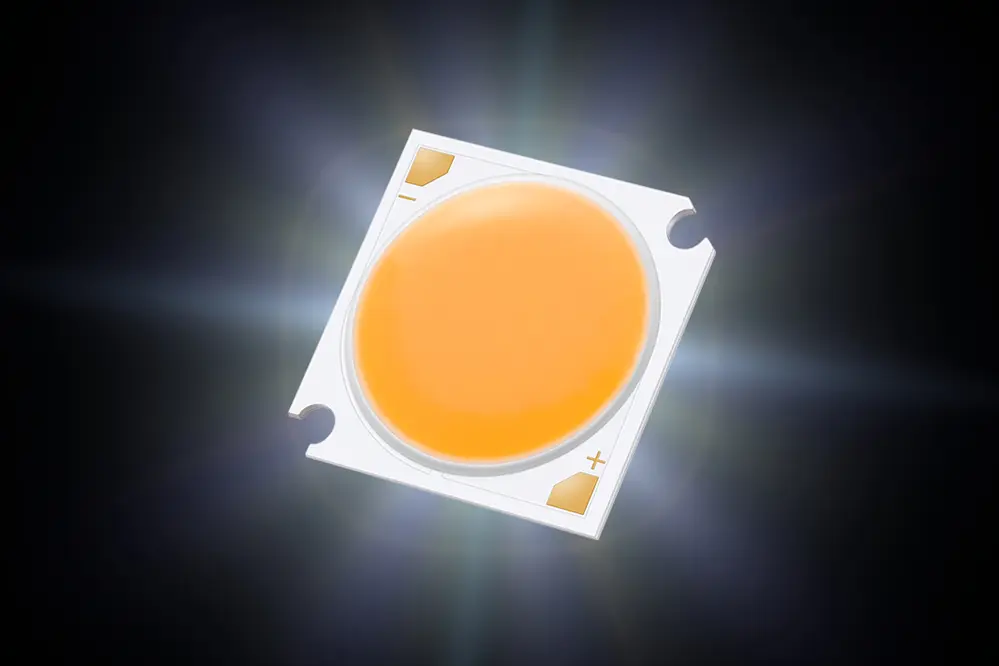What do you envision when you hear the term “COB LED”? For many lighting aficionados and professionals, it conjures images of seamlessly luminous surfaces, devoid of the spotted appearance often associated with traditional LED arrays. The advent of COB, or “Chip on Board” technology, has indeed elevated the aesthetics and functionality of light-emitting diodes to new heights.
COB LEDs, illumination redefined.
In stark contrast to their predecessors, COB LEDs offer a clean expanse of light. They achieve what once seemed elusive – a near-perfect diffusion of photons, ensuring that spaces are bathed evenly in light.
Decoding COB LED Technology
COB, an acronym for Chip On Board, represents a leap forward in LED technology. This approach involves mounting multiple LED chips directly onto a substrate to form a single module. When the module is energized, it emits a light that is distinctively uniform, distinctly devoid of the visible spots typically associated with individual LEDs, thus creating a smooth lighting experience that enhances both the aesthetics and functionality of the illuminated space.
The advantages of COB LEDs are manifold. Their energy-efficient design not only consolidates numerous light sources into one robust area, but also generates a higher intensity of light per unit area. This improved luminance, coupled with a more homogenous light distribution, makes COB technology an increasingly preferred choice among lighting professionals and enthusiasts alike.
COB LEDs: The Basics
COB, or Chip On Board technology, represents an advanced methodology in the realm of LED illumination, achieving a seamless and even light output. This improves both the ambiance and the utility of spaces.
Unlike traditional SMD (Surface Mounted Device) LEDs, which have discrete points of light, COB LEDs combine multiple light-emitting chips on a single module, reducing glare and creating a harmonious beam without visible spots.
COB technology heralds enhanced luminary efficacy alongside a remarkably uniform light dispersion.
By integrating numerous diodes on one circuit board, COB LEDs allow for a denser LED array that delivers an exceptionally bright and uniform light. Ideal for many applications, it bridges the gap between aesthetics and efficiency with its cutting-edge performance.
How COB Improves Lighting?
COB LED technology presents an epitome of luminary sophistication by producing an enhanced light quality, with a smooth and uniform output. The absence of spottiness yields a cleaner aesthetic and elevated visual comfort. The high-density diode arrangement inherent to COB LEDs results in a brilliantly even light that can fill a space with minimal shadowing, advancing the technology’s desirability for ambient lighting. Achieving higher lumens per watt, COB LEDs not only surpass SMD LEDs in brightness but also showcase superior thermal performance, allowing fixtures to maintain cooler operation, thereby extending their lifespan and reliability. This harmonious integration of brightness, longevity, and uniformity positions COB as a premier choice for sophisticated and sustainable lighting designs.
COB vs. SMD: The Core Differences

COB, or “Chip on Board” technology, employs a method where multiple LED chips are packaged together as one lighting module, which when illuminated, resembles a panel of light rather than discrete points. This architecture enables a substantial luminous surface, resulting in homogenous light with minimal granularity and shadow effects, thus enhancing the visual comfort in various settings. On the other hand, SMD, short for “Surface-Mounted Device,” relies on individually mounted LEDs on a circuit board, visible as distinct points of light.
The debate over COB versus SMD pivots around performance traits such as brightness levels and application adaptability. COBs tend to radiate a stronger and more cohesive light output, making them beneficial for high-intensity and uniform lighting applications. Conversely, SMD LEDs offer a broader versatility in color and design configurations, accommodating a vast array of customizable lighting solutions that can be tailored to specific aesthetic or functional requirements.
Structural Variations
COB LED technology simplifies the structural complexity of lighting arrays.
- COB LEDs consolidate numerous LED chips into a singular module, optimizing space.
- SMD LEDs disperse individual components across a printed circuit board, offering design flexibility.
- Performance varies greatly, with COBs leading in uniformity and SMDs in customization.Choosing between COB and SMD LEDs hinges on the application’s specific lighting needs.COB LEDs are revered for their unity in design and light distribution, whereas SMD LEDs cater to diversity.
Performance Metrics
Efficacious illumination is a paramount factor in assessing COB and SMD technologies, which differentiate particularly in flux density, thermal management, and long-term stability. COB LEDs, offering high luminous efficacy, shine when it comes to sustaining brightness over large areas without perceptible spots.
Beam quality, hence diffusion, remains superior with COB over many SMD alternatives. This is due in part to the closely packed LED chips of COB modules, which contribute to their homogenous light output and reduced glare. SMD LEDs, by contrast, may exhibit more pronounced variations in these attributes due to their dispersed nature.
COBs excel in delivering a uniform light with fewer shadows and a consistent intensity across the illuminated surface. Contrastingly, SMD LEDs may reveal multiple shadow casts (an artefact from the individual LED spacing) and variability in intensity.
The thermal performance of COB LEDs is usually more robust because of the integrated package design that enables more efficient heat dissipation. This directly impacts the lifespan and color stability of the LEDs, with COBs generally offering improved longevity and light quality due to better thermal management.
In terms of luminance, COB LEDs can achieve higher intensity levels due to the concentration of multiple LED chips, which allows for a more focused beam of light when necessary. Contrastingly, individual SMD LEDs generate lower output levels but offer greater design flexibility for various lighting requirements.
Ultimately, the key to choosing between COB and SMD LED technology hinges on the intended application’s performance criteria. Quality of light, including brightness and uniformity, alongside heat dissipation and durability, are pivotal considerations in determining the superior solution for specific lighting scenarios.
The Brightness Factor
When evaluating COB versus SMD LED technologies, lumen output often becomes a focal point of comparison. COB LEDs, with their multi-chip packaging, typically emit a more intense, bright light from a single point, which can result in a more consistent beam pattern.
However, one must consider that brightness is not solely a function of LED configuration. The optical design, such as lenses or reflectors used with COBs or SMDs, plays a significant role in shaping and intensifying the perceived brightness of the light, thereby influencing the overall lighting effect.
Despite the design variances, COBs generally provide a higher lumen-to-watt ratio compared to SMD LEDs, often making them the preferred choice when brightness is a critical parameter in lighting applications.
Lumen Output Comparison
The lumen output is a critical metric in assessing LED performance, directly influencing brightness perception.
- COB LEDs often produce a higher lumen output per watt, equating to enhanced brightness.
- SMD LEDs tend to have a broader light dispersion which can reduce the intensity of light perceived when compared to COB LEDs.
- The density of the LED chips in COB technology allows for a concentrated and intense light output.
While lumens measure brightness, the concentration of light plays a vital role in the user experience.
COB LEDs offer superior brightness in focused applications, while SMD can illuminate larger areas with less intensity.
Choosing the Right LED
When contemplating an LED choice, discerning between COB (Chip on Board) and SMD (Surface Mounted Device) technologies involves considering each’s strengths. COB LEDs emerge as leaders for high-intensity spotlights and applications requiring a uniform light without visible spots. Their construction, which packs LED chips closely together, creates a single light module, minimizing the granularity of the light source.
For projects that demand widespread illumination, SMD LEDs are often the more suitable option. These LEDs are characterized by individual diodes positioned on the surface of the circuit board, allowing for a broad spread of light. In scenarios where nuanced control over lighting zones and a softer dispersion is desired, SMD LEDs may offer a more fitting solution. When the choice is made, it must align with specific lighting requirements and the characteristics of the application to ensure optimal performance and satisfaction.
Factors to Consider
When juxtaposing COB and SMD LED technologies, one must weigh thermal management efficacy, design complexity, lighting consistency, and desired application outcomes. COB’s compact structure favors efficient heat dissipation, while SMD allows for multiple diodes with individual heat sinks.
Beam angle acuity impacts the lighting distribution, a critical aspect where COB excels due to its unified light source.
Conversely, SMD’s discrete diodes afford greater customization in creating specific lighting patterns, offering versatility (albeit sometimes with reduced intensity) in varied applications.
Durability is another factor; COB LEDs typically have a robust design due to fewer soldering points, potentially reducing the likelihood of circuit malfunctions or diode failures.
When considering maintenance and repair costs over the lifespan of the lighting solution, COB’s integrated approach may simplify servicing, whereas SMD may offer component-specific replacements, lessening the need for blanket module changes.
Finally, the luminous efficacy—lumens per watt—should inform the decision process. COB LEDs frequently show a higher lumen density, which translates to brighter illumination within a compact area.
Applications of COB LEDs

COB LED technology, revered for its superior brightness and light uniformity, caters to a wide array of lighting needs.
- General Illumination: Combined in LED strip lights, ideal for residential and commercial spaces due to their expansive beam angle and high-quality light output.
- Automotive Lighting: Employed in headlamps and interior lights, COB LEDs provide enhanced visibility with compact form factors.
- Street Lighting: Their high luminous efficacy and durability make COB LEDs suitable for outdoor, large-scale lighting projects.
- Portable Lighting: Utilized in flashlights and headlamps where intense, focused light is required in a small footprint.
- Specialty Lighting: Applied in task lighting, studio lighting, or medical applications where precision and reliability are paramount.These applications benefit from COB LEDs’ homogenous light dispersion, mitigating hotspots common in other LED technologies.With the ability to support lighting designs that require a blend of high intensity and aesthetic integration, COB LEDs are an increasingly popular choice.
FAQs
What does COB stand for in LED lights?
COB stands for Chip on Board technology.
In essence, COB LED implements numerous LED chips in close proximity on a single substrate. This configuration enables a uniform light distribution, as opposed to the point-like spots produced by other LED types. Beneficially, COB LEDs maintain the continuity of luminance without perceptible gaps or discontinuities in the light output.
What is the difference between SMD and COB light LEDs?
SMD LEDs, or Surface-Mounted Device LEDs, consist of individual chips.
Comparatively, COB LEDs house multiple LED chips directly on the substrate – creating a single module that emits a broad beam of light. The SMD LED, conversely, is built with separate, discrete LEDs mounted on the surface, allowing for greater design versatility but also potentially creating less uniformity in light distribution.
Which is better and brighter: COB or SMD LEDs?
The superiority of COB or SMD varies based on application requirements.
Brighter illumination is often associated with COB light LEDs due to their dense LED packaging and expansive light emission, making them ideal for scenarios where consistent, non-dotted lighting is crucial. SMD LEDs, while flexible in configuration, are generally less luminous on an equal-chip basis but can be arrayed to increase brightness.
What are the advantages of COB LED lights?
COB LED lights, or Chip-on-Board LED lights, offer several advantages in the world of lighting. First and foremost, they provide a high level of brightness and luminous efficacy. The integration of multiple LED chips into a single module allows for a more concentrated light source, resulting in greater intensity and improved illumination.
In addition to their brightness, COB LED lights also offer excellent thermal management. The compact design of the chip-on-board module allows for efficient heat dissipation, preventing the LED from overheating and prolonging its lifespan. This makes COB LED lights a reliable and long-lasting lighting solution.
Another advantage of COB LED lights is their versatility. With a wide range of color temperatures available, from warm to cool, they can be used for various lighting applications, including residential, commercial, and outdoor lighting. COB LED lights also have a high color rendering index (CRI), ensuring that colors appear vivid and natural.
Lastly, the design of COB LED lights allows for flexibility in terms of beam angle and size. The close proximity of the LED chips within the module produces a uniform light distribution and eliminates the appearance of multiple shadows. This makes COB LED lights ideal for applications that require precise and even lighting, such as task lighting and accent lighting.
Overall, the advantages of COB LED lights include high brightness and efficacy, efficient thermal management, versatility in color temperature, and uniform light distribution. These features make them a popular choice among lighting enthusiasts and professionals alike.
What are the disadvantages of COB lighting?
While COB lighting offers several advantages, there are a few downsides to consider. First, COB LEDs can generate a significant amount of heat, requiring proper heat dissipation measures. Second, the large size of COB modules may limit their use in certain applications with limited space. Lastly, COB lighting typically has a higher initial cost compared to traditional lighting solutions.
Are cob LEDs energy-efficient?
Yes, COB LEDs, or Chip-On-Board LEDs, are highly energy-efficient due to their advanced design and packaging, which allows for better thermal management and increased light output per watt, making them an excellent choice for lighting solutions that prioritize energy conservation and sustainability.
Are cob LEDs flicker-free?
No, COB LEDs are not inherently flicker-free. In 2016, when COB LEDs gained popularity, there were concerns about their potential for flickering due to their design. Flickering can occur when the current supplied to the LED fluctuates rapidly, resulting in visible flickering or strobing effects.
However, modern COB LED technology has evolved, and manufacturers have implemented various techniques to reduce or eliminate flickering. One approach is to use high-quality drivers and power supplies that provide a steady and constant flow of current to the LEDs, minimizing the chances of flickering. Additionally, some COB LEDs incorporate built-in flicker mitigation features, such as advanced dimming capabilities and enhanced circuit design.
It is important to note that not all COB LEDs are flicker-free, as the presence of flicker can vary depending on the specific model and manufacturer. Therefore, it is recommended to check the specifications and documentation provided by the manufacturer to determine if a particular COB LED is indeed flicker-free.
Ultimately, flicker-free lighting is crucial for applications where flickering can cause discomfort or affect visual perception, such as in residential lighting, photography, or slow-motion video recording. Choosing flicker-free COB LEDs or utilizing additional flicker mitigation measures can help ensure a consistent and comfortable lighting experience.
Where to use cob LEDs?
COB LEDs, or Chip-on-Board LEDs, are highly versatile and can be used in a variety of applications. In the field of lighting, COB LEDs are commonly used in high-output fixtures, such as floodlights, track lights, and downlights. Their compact size and high lumen output make them ideal for these types of applications.
COB LEDs are also popular in the automotive industry, where they are used for headlights, taillights, and interior lighting. Their ability to produce a large amount of light in a small space makes them a preferred choice for automotive lighting.
In addition, COB LEDs are widely used in the horticulture industry for indoor plant cultivation. The high lumen output and full spectrum color options of COB LEDs provide plants with the necessary light intensity and wavelengths for optimal growth.
Another area where COB LEDs are commonly used is in display lighting, such as in museums, galleries, and retail stores. Their high color rendering index (CRI) and uniform light distribution make them ideal for showcasing artwork, products, and exhibits.
Overall, the versatility and performance of COB LEDs make them suitable for a wide range of applications, including but not limited to general lighting, automotive lighting, horticulture lighting, and display lighting. It is important to consider factors such as desired light output, color temperature, and CRI when choosing COB LEDs for a specific application.
Conclusion
In the realm of LED lighting technologies, COB LEDs excel in producing a uniform continuum of light, free from the spotting effect, offering a cohesive and aesthetically pleasing beam. This characteristic is especially advantageous in applications where a seamless wash of light is essential.
SMD LEDs offer modularity and versatility in design, allowing for custom configurations catering to diverse lighting needs.
Nonetheless, when intensity and even light distribution are paramount, COB LEDs are the preferred choice, thanks to their contiguous LED chip placement and higher luminescent efficacy.
Combining intensity with uniform illumination, COB LEDs serve well in environments requiring broad, consistent light without the granularity sometimes witnessed with SMD arrays.
While SMD LEDs can be strategically aligned to match COB levels of brightness, this requires careful planning and design, thus adding to the complexity and potential cost of the lighting solution.
Ultimately, both COB and SMD LEDs have their distinct places in the illumination landscape. Their selection depends heavily on the specific demands of the application, balancing factors such as brightness, consistency, and design complexity.
If you are a lighting enthusiast or professional seeking high-quality LED strip lights and LED neon strips with COB and SMD LEDs, look no further than Unitop. As one of the most professional manufacturers, factories, and suppliers in the industry, Unitop offers a wide range of reliable and innovative LED lighting solutions. Contact Unitop today to elevate your lighting experience.





